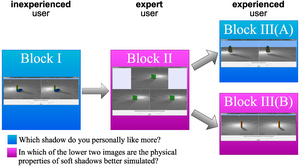Information
- Publication Type: Master Thesis
- Workgroup(s)/Project(s):
- Date: October 2012
- Date (Start): 1. January 2012
- Diploma Examination: 9. October 2012
- First Supervisor: Michael Wimmer

- Keywords: Perception Studies, Soft Shadows
Abstract
While a huge body of soft shadow algorithms has been proposed, there has been no methodical study for comparing different real-time shadowing algorithms with respect to their plausibility and visual appearance. Therefore, a study was designed to identify and evaluate scene properties with respect to their relevance to shadow quality perception. Since there are so many factors that might influence perception of soft shadows (e.g., complexity of objects, movement, and textures), the study was designed and executed in a way on which future work can build on. The evaluation concept not only captures the predominant case of an untrained user experiencing shadows without comparing them to a reference solution, but also the cases of trained and experienced users. We achieve this by reusing the knowledge users gain during the study. Moreover, we thought that the common approach of a two-option forced-choice-study can be frustrating for participants when both choices are so similar that people think they are the same. To tackle this problem a neutral option was provided. For time-consuming studies, where frustrated participants tend to arbitrary choices, this is a useful concept. Speaking with participants after the study and evaluating the results, supports our choice for a third option. The results are helpful to guide the design of future shadow algorithms and allow researchers to evaluate algorithms more effectively. They also allow developers to make better performance versus quality decisions for their applications. One important result of this study is that we can scientifically verify that, without comparison to a reference solution, the human perception is relatively indifferent to a correct soft shadow. Hence, a simple but robust soft shadow algorithm is the better choice in real-world situations. Another finding is that approximating contact hardening in soft shadows is sufficient for the average user and not significantly worse for experts.
Additional Files and Images
Additional images and videos
Additional files
 thesis
thesis:
A Comparative Perceptual Study of Soft Shadow Algorithms.pdf
Weblinks
No further information available.
BibTeX
@mastersthesis{hecher-2012-MH,
title = "A Comparative Perceptual Study of Soft Shadow Algorithms",
author = "Michael Hecher",
year = "2012",
abstract = "While a huge body of soft shadow algorithms has been
proposed, there has been no methodical study for comparing
different real-time shadowing algorithms with respect to
their plausibility and visual appearance. Therefore, a study
was designed to identify and evaluate scene properties with
respect to their relevance to shadow quality perception.
Since there are so many factors that might influence
perception of soft shadows (e.g., complexity of objects,
movement, and textures), the study was designed and executed
in a way on which future work can build on. The evaluation
concept not only captures the predominant case of an
untrained user experiencing shadows without comparing them
to a reference solution, but also the cases of trained and
experienced users. We achieve this by reusing the knowledge
users gain during the study. Moreover, we thought that the
common approach of a two-option forced-choice-study can be
frustrating for participants when both choices are so
similar that people think they are the same. To tackle this
problem a neutral option was provided. For time-consuming
studies, where frustrated participants tend to arbitrary
choices, this is a useful concept. Speaking with
participants after the study and evaluating the results,
supports our choice for a third option. The results are
helpful to guide the design of future shadow algorithms and
allow researchers to evaluate algorithms more effectively.
They also allow developers to make better performance versus
quality decisions for their applications. One important
result of this study is that we can scientifically verify
that, without comparison to a reference solution, the human
perception is relatively indifferent to a correct soft
shadow. Hence, a simple but robust soft shadow algorithm is
the better choice in real-world situations. Another finding
is that approximating contact hardening in soft shadows is
sufficient for the average user and not significantly worse
for experts.",
month = oct,
address = "Favoritenstrasse 9-11/E193-02, A-1040 Vienna, Austria",
school = "Institute of Computer Graphics and Algorithms, Vienna
University of Technology ",
keywords = "Perception Studies, Soft Shadows",
URL = "https://www.cg.tuwien.ac.at/research/publications/2012/hecher-2012-MH/",
}
 Image:
The block design of our study.
Image:
The block design of our study.
 thesis:
A Comparative Perceptual Study of Soft Shadow Algorithms.pdf
thesis:
A Comparative Perceptual Study of Soft Shadow Algorithms.pdf

 poster
poster thesis
thesis
